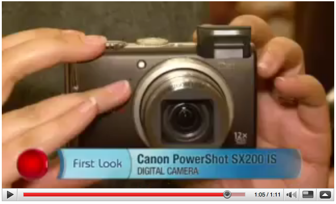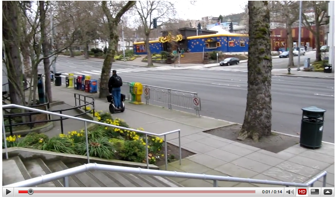This is the Canon PowerShot SX200 IS:
Download the Canon SX200 IS Manual.
Check the latest Canon 60D price trend and in-stock availability.
The Canon SX200 IS has been superseded by the Canon SX210 IS.
Check the most recent updates for Canon SX200 IS price trend and in-stock availability.
Reviews
Canon SX200 IS vs Panasonic ZS3 / TZ7, compared by Tom Hoots:
If you’re considering the SX200, and if you’re interested in a wider wide end, I’d recommend taking DPReview’s advice, and check out the Panasonic ZS3 instead.I recently did some horse-trading and traded my ZS3 away — “I can always go get another one.” But, when the time came to head into the store, I figured I’d give the SX200 a shot, instead. Oh, man. It’s not even close. I just want a long-zoom camera to have sitting in a bag, for when I need it, while I use a pocket camera for most of my shooting. And the SX200 will suffice for that. But, as a bigger-yet-still-pocketable, all-around camera, the ZS3 just shines. It’s great fun to use, while the SX200 is, well, “a load.”
The image quality isn’t really that far off between the two cameras — I was more than happy with the ZS3’s “vivid” color mode, and the SX200 has good, old “Canon color.” But I’m talking more about routine, everyday handling — the ZS3 is just “more inviting” — “more fun.” It just fits in the hand better, has a better screen, and so on — it’s just a joy to use. I’d easily recommend it to anyone who might be interested in one of the “pocket superzooms.”
SX200IS Review at Macworld
Tim Moynihan, the reviewer, points out a little known benefit of the video mode on the SX200:
In my informal hands-on testing, I quickly became hooked on two fun in-camera features: Color Accent mode and Color Swap mode. In Color Accent mode, you can designate a color in your scene as the only color to show up in an otherwise black-and-white photo, meaning you can take no-brainer artistic shots. In the similar Color Swap mode, you can replace all instances of one color in your scene with another color, say, brown with blue.Oh, and it gets better. You can shoot HD video in both of those modes, making for instant art-school films with no post-production work necessary. The SX200 IS shoots 1280-by-720 HD video at 30 frames per second (it also shoots 640-by-480 and 320-by-240 standard-definition clips at that frame rate), and it offers an HDMI-out port so that you can show your clips on an HDTV set directly from the camera
The Canon SX200 was awarded an overall rating score of 4 out of 5 stars.
Luminous Landscape compares Fuji F200EXR vs Panasonic ZS3 vs Canon SX200
LL compares three cameras, the Fujifilm FinePix F200EXR, the Panasonic Lumix DMC-ZS3 / DMC-TZ7 and the SX200IS in their article titled “Pocket Camera as Visual Notebook“.
Michael Reichmann, the reviewer, has this to say of the SX200 IS:
The SX200 IS is the largest of the three cameras and has the longest zoom and highest density sensor. With 12 MP and a 28-336mm range (f/3.4 — 5.3) it offers tremendous reach for its size, but at the cost of the lens being a bit slow and not quite as wide as that of the ZS3.Unfortunately the image quality of the SX 200 isn’t up to that of either of the other two cameras in this comparison. Purple fringing is very apparent, and high ISO (above 200) starts to smear and lose resolution quite readily.
Canon PowerShot SX200 IS review at CameraLabs.com
Gordon Laing, the reviewer, issues the following verdict for the SX200:
As we said at the top of this page, the PowerShot SX200 IS is Canon’s first attempt at a pocket super-zoom, and it’s certainly impressive, packing a 12x zoom, 3in screen, HD movies, an HDMI port and full manual control into a pocketable form factor. Viewed in isolation it’s a highly compelling prospect.
Take note that Gordon favors buying the Panasonic Lumix DMC-ZS3 / DMC-TZ7 instead, and lists the reasons why, on the verdict page.
Canon SX200 IS Review at CNET UK
Rod Lawton, the reviewer assigned the SX200 a test score of 6.2 (Good), and gave the following conclusion:
The Canon PowerShot SX200 IS’ manual exposure modes might tempt keen photographers, but these are undermined by the awkward controller. The image stabilisation is good, but the pictures are average. You’d have to be a real Canon fan to pick this camera over its rivals, which include the smaller, cheaper and much better Panasonic Lumix DMC-TZ6.
Noteworthy is Rod’s preference for the Panasonic DMC-ZS1 / DMC-TZ6 camera.
Canon PowerShot SX200 IS Review at DigitalCameraReview
David Rasnake, the reviewer, hands the following verdict for the SX200 IS:
On the one hand, the Canon PowerShot SX200 IS is both seemingly everything our editorial staff looks for in a camera, and everything we’ve come to expect from Canon. It’s a solid, better-than-average performer in most respects, with great zoom range, wide-ranging control options to please everyone from novices to enthusiasts, a lucid interface, 720p video capture, and decent construction.
User impressions by Ezzelin
Ezzelin has posted a lengthy review of the SX200 IS on DPReview, and is happy with the purchase.
A summary of the points follow:
- It’s small.
- It has tons of features.
- Image quality is great.
- The camera goes into a small, neoprene case which fits into the front pants pocket.
- The flash pops up when the camera is turned on, stays up until the camera is turned off, and cannot be manually retracted.
- There is no live histogram function, but blinking highlights display is availble during playback.
- The review histogram is very large, and can be set up to automatically come up as soon as the shot is taken. Alternatively, you can set the camera so that focus check is displayed instead.
- Detail at ISO 400 is retained rather well, and higher ISO capabilities are impressive as there is some luminance noise, but not much. Ezzelin shares some high ISO shots here.
- CA (chromatic aberration) gets worse as you zoom in.
- The 720p video is of a very high quality, and has the most detail Ezzelin has ever seen on pocket cameras. The bitrate averages about 23,000 to 24,000 kbps. Custom color and sharpness settings can be applied to the video, allowing for post-editing enhancements later on.
- The focus is fixed once video capture starts, but Ezzelin feels that this is not too big an issue.
- The rear LCD is big and bright, and the image can still be viewed even in bright conditions.
Canon PowerShot SX200 IS Review by DCResource.com
Jeff Keller, the reviewer, reveals that Canon no longer bundles a free memory card with the camera, so it’s best to get at least a 2 GB or 4 GB SD or SDHC card.
For best video recording performance, purchase an SDHC card with a minimum of Class 6 speed specification.
On build quality, Jeff says:
The PowerShot SX200 is a more “upscale” version of the SX100 and SX110 that came before it. It has a compact (by ultra zoom standards) body made almost entirely of metal, and it feels very solid. The only weak spot is the somewhat flimsy door over the battery/memory card compartment. The camera is easy to hold, with a nice spot for your right thumb, and easy access to the most commonly used controls. The SX200’s flash pops up automatically when you turn the camera on (and stays there), but Canon thoughtfully left room for your fingers right behind it.
Unlike on the Panasonic ZS3 / TZ7, you don’t get stereo sound recording with the SX200 IS, so audio quality is better on the Panasonic.
On image quality:
The same things that I’ve written over the last year about Canon’s compact cameras can basically be repeated here. The PowerShot SX200 produces very good quality photos, given that there’s enough light. Exposure is generally good, though like most point-and-shoot cameras, it’s prone to highlight clipping. Colors looked great — I have no complaints there. Photos have that trademark Canon smooth look, which I always find quite appealing. Canon seems to use more noise reduction on their DIGIC 4 cameras than they used to, so details are a bit more smudged that PowerShots of years past. Even so, the SX200 still does better than most ultra zoom cameras when it comes to detail retention. Purple fringing levels were low to moderate.
Jeff has the following conclusion for the SX200:
The Canon PowerShot SX200 IS is a very capable and compact ultra zoom camera. It offers very good photo quality, a 28 — 336 mm lens, a nice combination of automatic and manual controls, a large LCD, and a HD movie mode. It’s not perfect though; it has a weak, slow-to-charge flash, battery life is below average, and you can’t zoom while recording a movie mode. Despite that, the PowerShot SX200 is a good choice for a travel camera, and it earns my recommendation.
SX200 IS hands-on by PhotographyBlog
PB got to play with the Canon 200 IS at the London launch, and in their Canon SX200 IS Hands-On article, they write that the SX200IS was bigger and chunkier than the equivalent Panasonic Lumix DMC-TZ7.
The Panasonic TZ7 / ZS3 will very likely be the competing camera to the SX200 IS.
Miscellaneous Reviews and Previews on YouTube
Click the thumbnails to view the video clips in a new browser window.
Canon PowerShot SX200 IS first look by Molly Wood of CNet

First Look Review of the Canon Powershot SX 200IS by MegaWhat.tv

Sample Photos
Eight Canon SX200 IS review samples at DigitalCameraReview.com
Go to the bottom of DCR’s SX200IS review where you’ll find 8 thumbnails that will take you to full-resolution images when clicked on.
Footage, movie and video clip samples
Canon Powershot SX200 IS sample movie clip at DCResource.com
Visit DCResource’s Canon SX200 IS review, and scroll down until you reach almost the end or the article where the link to the movie is found.
Alternatively, right-click this link to save the 31.9 MB, 1280 x 720, 30 fps, QuickTime format video clip to your hard drive.
Canon Powershot SX200 IS Test Video at 720p by Ezzelin
Click to view Ezzelin’s HD (high definition), 14-second footage on YouTube in a new browser window.
The lens on the SX200 was zoomed out to the extreme wide-angle focal length, which is 28mm in 35mm equivalent terms.
You can download the original file at MediaFire.
Tips
How to access the “Program Shift” function
Ezzelin shares a method for using the “Program Shift” function, which is not properly documented in the Canon SX200 IS manual.
Here’s one thing that I discovered about it that I didn’t know: it does have program shift! However, it’s undocumented in the manual and a little hard to do. Here’s how it works: First, you half press the shutter button. Then, while holding that down, you press up on the wheel. This locks your exposure (AE lock), or flashes the flash and locks the exposure if the flash is enabled (FE lock). If you’re using AE lock, you can then spin the wheel and select between different equivalent exposures if more are available. A little inconvenient, and I’m not sure how much I’ll use it, but it’s there, and the dcresource review said it wasn’t (and it isn’t in the manual in the AE lock section, either.) There are grayed out arrows that show after doing FE lock, so it might be possible then, too, but I’ve never seen the arrows anything but gray.
Consider setting sharpness at -2
Ezzelin recommends sharpness to be dialed down to -2, instead of being left at the default 0:
I took a few more shots comparing the sharpness modes, and it looks like Sharpness -2 is definitely the way to go, as I expected. The images can be sharpened to the level of Sharpness 0 in post without as many halos, and the files usually come out 200KB or so smaller due to having less noise to compress.
Best lens position for macro / close-ups
One more neat thing I’ve found is that the camera can take fairly good macro shots at just shy of 50mm equivalent (47ish). Right around that point, the camera switches from 15cm min focus to 35cm min focus in Macro mode. So if you zoom to the focal length right before the switch, you can take fairly close macro shots at a good working distance with nice DOF control and very low, if any, barrel distortion. The minimum f stop is still 4.0 at this focal length, as well. It’s certainly a good sweet spot for the lens.
So, set the focal length of the lens just slightly shorter than 50mm, and stop down the aperture to f/4 for close-up shooting.
Resources
Official Canon SX200 IS page at Canon USA.
Related
Canon cameras – Main page



